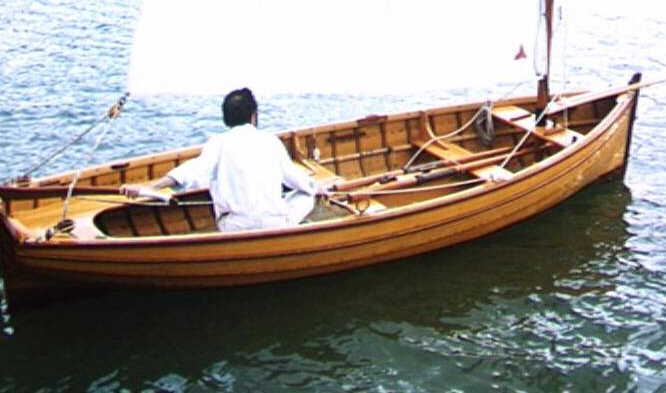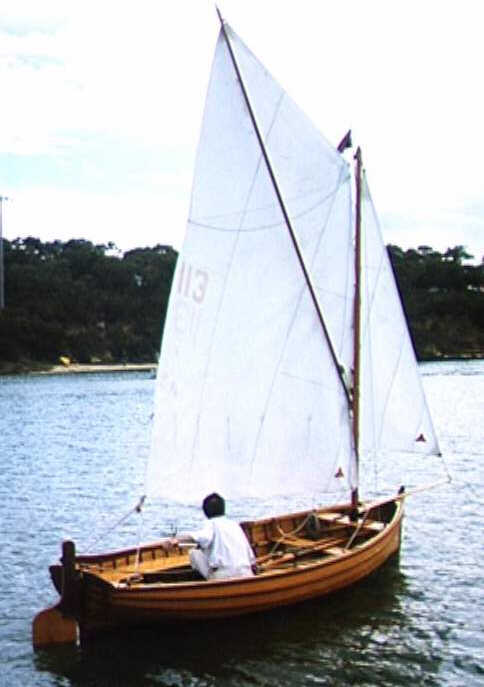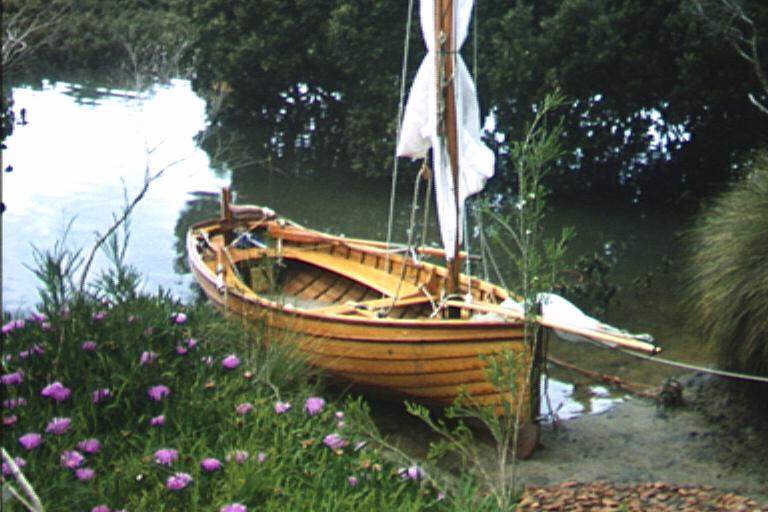
Back to The Boats of Swallows and Amazons
Mike Field's Aileen Louisa

About the middle of 1998, Mike Field bought a boat. Having thrived on a diet of Arthur Ransome books as a boy, Mike wanted not just any boat, but a wooden boat—in point of fact an open clinker boat. And, courtesy of his local yacht broker, he found one.
Aileen Louisa, as the boat is now called, is 15' long, has a 5' beam, and draws about 6" with the centreboard up. With her wineglass transom, fine quarters, straight stem, and long keel she is an excellent pulling boat (about one stroke every five yards!) and she is sloop-rigged, with a sprit mainsail of 100 square feet. Apart from the antifouling underneath, she's varnished inside and out. She is Mike's pride and joy.
The previous owner had added a few bits and pieces that Mike thought were out of place on such a vessel. So he replaced the chromed fairleads at the stem with bronze ones (adding another pair at the blunt end as well,) and did away with the stainless steel blocks that the mainsheet had been led through. He also did away with the main boom with which she had been fitted, and which was really redundant in view of the sprit. (This also now allows him to brail up the mainsail on occasion, which is a very convenient possibility with the sprit rig.)
Rerigging thus started, things seemed to get a bit out of hand, and a variety of new but traditional fittings presented themselves as being altogether indispensable: Two new wooden blocks to augment the last remaining one from the original rig, to allow the use of a double-ended mainsheet Wooden saddles on the quarter-knees to shackle the new blocks to Wooden fairleads on the hanging knees supporting the centre thwart, to lead the jibsheets back to the stern for single-handed sailing Wooden thumb cleats forward of the fairleads to snub the sheets under, and so alter the lead, when sailing close-hauled A wooden horn cleat on the sprit to which to belay the snotter (the line that supports the sprit and thus makes the whole thing work) Two thumb cleats on the mast to locate the snotter for sailing with the sail full or reefed Wooden kevels (two pairs, amidships and forward) to allow quick belaying of mooring lines A pennant staff to allow the new burgee to swivel freely above the masthead to show direction of apparent wind And finally, a new "positive-attitude" boathook with bronze head, complete with decorative rope handgrip and a lanyard at the head
(There was other work done, too, including provision of ringbolts through the sternpost and hog to shackle anchor cables to, cutting and lining of a sculling notch in the transom, insertion of a bronze sheave at the masthead for the main halliard—which, until then, had simply run through an open slot—and trimming the bottom of the rudder back to keel level to allow for bottoming out each tide on the Western Port mud.)
Purchase of the mainsheets blocks proved to be a hazardous experience. Mike had some trouble in locating any wooden blocks at all at first. Then when he found some in an exclusive Victorian bayside chandlery, they weren't stropped, they were fitted with (he could hardly believe it) white plastic sheaves, and they were ruinously expensive. To get them sufficiently authentic-looking (not to mention operable,) he turned two new wooden sheaves to replace the tacky plastic ones, further purchased two also-high-priced bronze thimbles from the same chandler, and then stropped and seized both blocks himself.
All in all, each block finally cost about $70 plus labour, which gave Mike pause for thought. From then on he made his own fittings from scratch—fairleads, cleats, saddles, pennant staff, boathook shaft, the lot.
While he knows that there isn't a great demand for wooden boat fittings, Mike also knows from his own experience just how hard it can be to get some if you want them. And that's how his company, Wooden Boat Fittings, came to be. This small company on the shores of Victoria's Western Port makes traditional wooden fittings by hand, the way it used to happen. ... The company uses a variety of different timbers for their fittings, depending on client preferences and intended use. Items are typically manufactured from redgum, jarrah, spotted gum, merbau, teak, oregon, or mahogany, although other timbers including cedar and ballart have also been used.
Rather than manufacture blocks himself, Mike chooses to source them from a reputable (and reasonably-priced!) block manufacturer he has since located, but all other fittings are made by the company itself. The list is a long one. It includes belaying pins, saddles, fairleads, toggles, pennant staffs, masthoops (hinged and plain,) beeblocks, deadeyes, thimbles, and bullseyes, togetehr with five varieties of cleats—pretty well any fitting from a mooring cleat for the foredeck to a jackstaff on the counter. ... any fitting can be fabricated to order.
Mike confesses that he doesn't have too much spare time at the moment, but in what he does have he is presently resurrecting an old flagpole and also working on a design for mud-shoes (splatchers) for use by people who, like him, keep their boats on the mud and are tired of losing their gumboots in it.
Mike Field
PO Box 30
Cranbourne MDC
Victoria, Australia 3977

